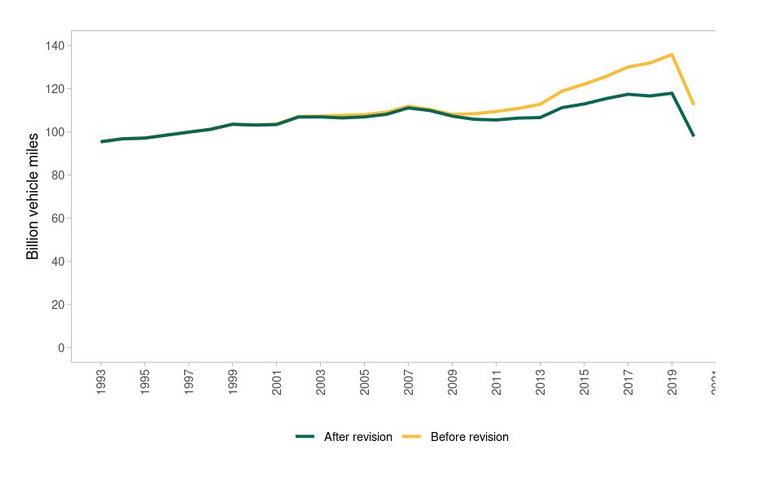I posted a blog last year reporting a revision to the Department for Transport’s road traffic statistics that found traffic in minor roads to have increased by 26% between 2010 and 2019. This compared to an increase in traffic on major roads over the same period of 12%. There were two things going on: a statistical sampling problem and a likely real increase in traffic on minor roads.
DfT practice is to monitor a representative sample of minor roads, scaled up to estimate traffic on all minor roads on the network. Because any sample may become less representative over time, a benchmarking exercise is carried out every ten years using a larger sample. This allows data inferred from the original sample to be adjusted retrospectively and a new sample to be established. In the previous 2009 benchmarking exercise the adjustment was fairly small, but not so in the most recent investigation.
Transport for London queried the DfT estimates, which did not square with its own estimates of traffic on the capital that showed a declining trend. Prompted by this discrepancy, the DfT statisticians carried out a deep dive into the methodology, the finding of which were published last September. The outcome has been to revised downward the estimated increase in minor roads traffic from the previous 26% to 10% over the period 2010 to 2019 (see chart above). This amounts to an unusually large revision, and has been accompanied by relegation of the previous report to the archives.
The explanation offered by the statisticians mainly involved comparison of the samples employed in the 2009 and 2019 benchmarking exercises, using GPS data to compare traffic flows, dichotomising into ‘high’ and ‘low’ flow links, and finding that there were 5% more high flow links in the 2019 sample. This was then included as an additional stratification factor for recalculating both exercises. In addition, the benchmarking estimates for London were recalculated, distinguishing Inner London and Outer London, which had not been done previously.
Transport for London, in its Travel in London Report 15 (page 141), notes that the revised DfT data for minor roads traffic in London, although smaller than previously estimated, still represents a substantial upward revision of this component of road traffic in London, whereas the DfT has not revised its traffic estimates for major roads in the capital. The outcome is that whereas in the estimates published before 2019, minor road traffic was put at around 33 per cent of all road traffic in London, the latest estimates have increased this proportion (of a correspondingly larger total) to around 40 per cent.
I have been interested in these estimates of traffic on minor roads since there is much anecdotal evidence that the widespread adoption of Digital Navigation (generally known as ‘satnav’ in the roads context) allows these roads to be used by those without local knowledge, leading to more traffic than desirable in the neighbourhoods affected. The new estimated of the pre-pandemic growth of traffic on minor roads brings this into line with growth on major roads, which might seem to argue against the significant impact of Digital Navigation.
Yet the size of the correction prompted by the benchmarking exercise points the other way, since had the sample of minor roads used to track traffic growth remained representative over the ten-year period, the increase in traffic would have been seen year on year. The fact that this was only recognised from the benchmarking suggests some increased heterogeneity in the sample. My hypothesis is that use of Digital Navigation would lead to growth of traffic on minor roads located adjacent to congested major roads, where the former offer a time-saving opportunity, while minor road located elsewhere would be less affected. The London data showing a growth of traffic on minor roads compared with that on major roads, noted above, is consistent with my hypothesis, given the extent of congestion in this city.
I have been in correspondence with the DfT statisticians on this question. What remains unclear to me is whether they regard controlling for flow characteristics as simply a matter of controlling for mismatched samples, or whether they accept the possibility that use of minor roads changed over the decade in a way that increased the heterogeneity of traffic growth. I have been told that the heterogeneity of traffic growth is not something that their data is currently suitable to verify beyond road class, vehicle type, and regional differences. However, they are looking at other ways of stratifying the sample and at other options for minor road sampling and counting in the future, including use of GPS data.
I have noted previously the likelihood that the use of Digital Navigation is facilitating the diversion of local traffic to new capacity on motorways. More generally, Digital Navigation is changing travel behaviour in ways that need to be better understood for decisions on road investment and other policies, in particular the promotion of walking and cycling for which minor roads are well suited. It is regrettable that the DfT is not able to shed light on these changes as part of its otherwise extensive and comprehensive compilation of road traffic statistics.
According to press reports, the European Commission is in discussion with providers of Digital Navigation services to protect people in neighbourhoods from noise and emissions by adjusting the routing algorithms, which is good news.

